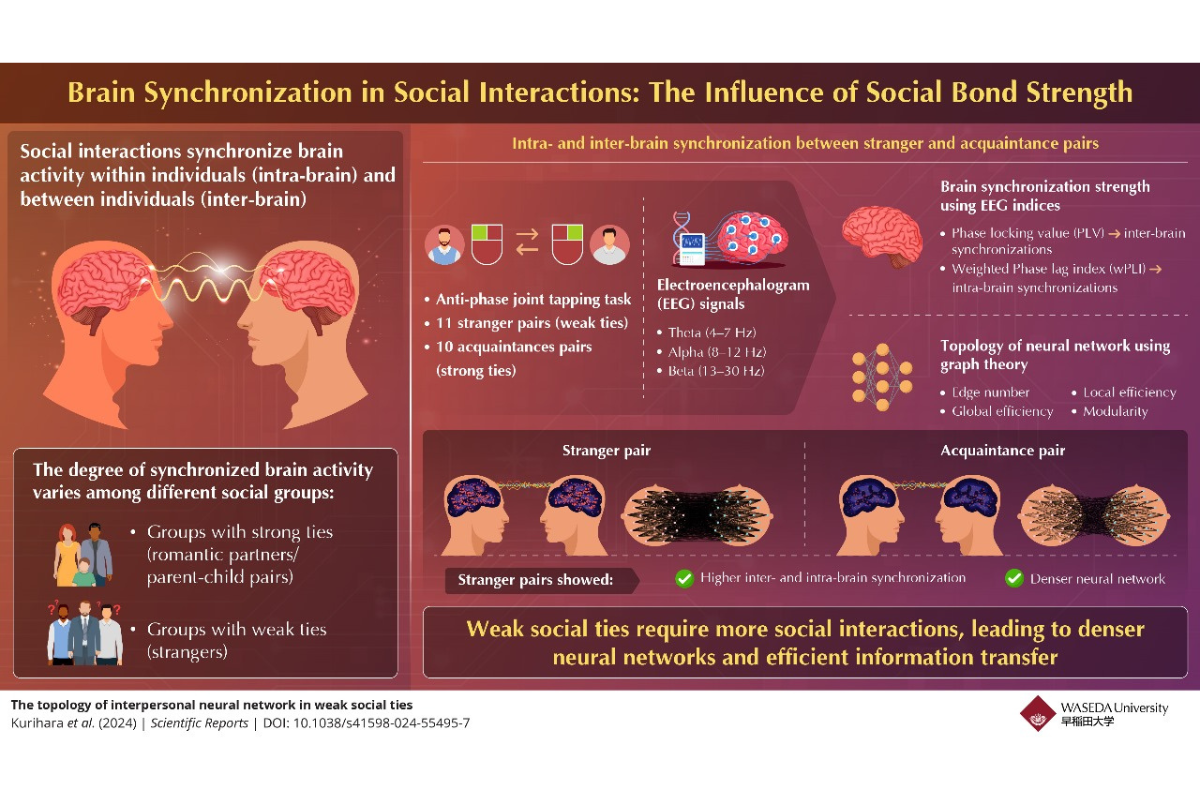Researchers investigate how social bonds influence neural synchronization in the brain during joint coordination tasks
Social interactions synchronize brain activity within individuals and between individuals. In a new study, researchers compared brain synchronization between pairs of people with relatively strong social ties (acquaintance pairs) and pairs with almost no social ties (stranger pairs). The study found that during a cooperative task, the stranger pairs exhibited more closely connected brain networks compared to the acquaintance pairs. These findings challenge the conventional understanding that stronger social bonds lead to greater brain synchronization.
We experience the world and connect with others through social interactions. Engaging in activities, such as conversations, cooperative tasks, and intimate relationships, deeply affect brain activity leading to coordinated neural activity within an individual’s brain (intra-brain synchronization) and between the brains of multiple individuals (inter-brain synchronization).
Researchers study brain synchronizations to understand the neural processes behind social behaviors. This knowledge can help diagnose and treat conditions like social anxiety and communication-related disorders. However, investigations on brain synchronization have primarily focused on groups with strong social ties, such as romantic couples and parents and children.
In a study published in Scientific Reports on February 29, 2024, researchers from Waseda University in Japan reveal that cooperative interactive tasks between individuals with weak social ties result in more synchronized brain activity compared to individuals with strong ties.
“Our findings challenge the conventional understanding that stronger social ties predict greater brain synchronization and offer fresh insights into neural networking during social interactions,” says lead researcher Dr. Yuto Kurihara, Research Associate at the Faculty of Human Sciences at Waseda University.
The research team also included Dr. Toru Takahashi from the Advanced Research Center for Human Sciences and Professor Rieko Osu from the Faculty of Human Sciences at Waseda University.
They studied 14 pairs of strangers who met for the first time and 13 acquaintance pairs, in which one participant brought their partner. Due to artifacts, 21 pairs were included in the analysis (stranger pairs: 11, acquaintance pairs: 10). The participants were given a joint tapping task, where they had to tap a mouse button in opposite rhythms. Each participant wore earphones to hear both their taps and their partner’s taps, and they had to anticipate their partner’s movements.
Brain activity was captured using electroencephalograph (EEG) electrodes placed on their scalp for four tapping conditions: slow tapping with a 0.5-second interval, fast tapping with a 0.25-second interval, tapping freely at their preferred frequency, and tapping coordinated with a metronome at 0.50-second intervals (a pseudo condition). The study investigated how brain signals synchronize across the theta (4–7 Hz), alpha (8–12 Hz), and beta (13–30 Hz) frequency bands.
EEG analysis revealed that pairs of strangers exhibited greater intra-brain synchronization in the theta band, compared to acquainted pairs. Furthermore, binary undirected graphs constructed to represent the connectivity between EEG channels showed that the neural network was more densely connected in strangers than in acquaintances.
“Surprisingly, despite having weaker social ties, stranger pairs demonstrated more robust intra- and inter-brain EEG networks than acquainted pairs,” comments Dr. Kurihara.
Researchers suggest that the lack of familiarity between strangers requires a more involved process for predicting each other’s actions or behaviors in a cooperative task. Consequently, this heightened engagement leads to a more efficient transfer of information between closely connected nodes within the neural network.
This finding underscores the importance of weak social ties in shaping social relationships and individual behavior. “By demonstrating that strangers exhibit heightened intra- and inter-brain synchronization, our research highlights the potential of weak ties in fostering new connections and understanding the neural underpinnings of social interactions,” says Dr. Kurihara.
















Got a Questions?
Find us on Socials or Contact us and we’ll get back to you as soon as possible.